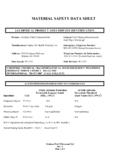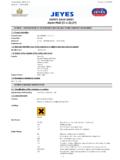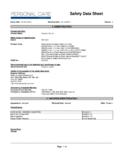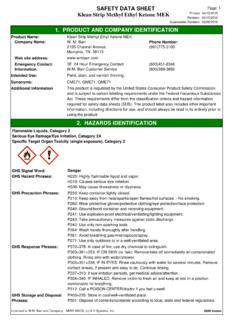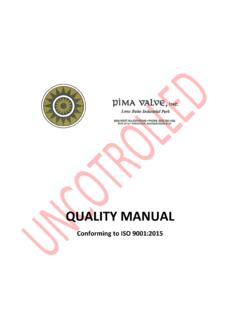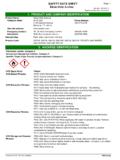Transcription of MATERIAL SAFETY DATA SHEET CryoPen, Inc. 2010 E ...
1 OM-CT2-02-R2 revised Page 1 of 4 MATERIAL SAFETY DATA SHEET CryoPen, Inc. 2010 E. Continental Blvd Suite D Southlake TX 76092 (877) 246-3955 SECTION 1: product AND company identification product Name: EVERCLEAR (grain alcohol) / CryoPen Reservoir Solution Manufacturer: David Sherman Corporation 5050 Kemper Avenue St. Louis, Missouri 63139 Information Phone Number: (314) 772-2626 Fax: Emergency Phone Number (Chemtrec): (800) 424-9300 North America (703) 527-3887 International Shipments MSDS Date of Preparation: 12/31/02 product Use: Beverage for Human Consumption/CryoPen Reservoir Solution SECTION 2: COMPOSITION/INFORMATION ON INGREDIENTS Chemical Name CAS Number Vol % Ethanol (ethyl alcohol) 64-17-5 95 SECTION 3: HAZARDS identification Clear liquid with a pleasant odor. EMERGENCY OVERVIEW WARNING! Flammable liquid and vapor. May cause eye, skin, and respiratory irritation.
2 Ingestion or inhalation of vapors may cause inebriation, euphoria, dizziness, drowsiness, nausea, and other symptoms of central nervous system depression. Ingestion of large amounts may result in narcosis, anesthesia, coma, respiratory failure and death. Chronic overexposure may result in dependency and effects on the nervous system, heart, liver, gastrointestinal system and pancreas. SECTION 4: FIRST AID MEASURES Eye: Rinse thoroughly with water, holding the eye lids open to be sure the MATERIAL is washed out. Get medical attention if irritation persists. Skin: Remove contaminated clothing. Wash contact area thoroughly with soap and water. Get medical attention if irritation or symptoms of exposure develop. Launder clothing before re-use. Inhalation: Remove victim to fresh air. Give artificial respiration if needed. If breathing is difficult, oxygen should be administered by qualified personnel. Get immediate medical attention.
3 Ingestion: This product is intended for ingestion in moderation. In cases of suspected poisoning or overdose, call a poison control center or hospital emergency department immediately and follow their instructions. Keep the victim calm and warm. SECTION 5: FIRE FIGHTING MEASURES Flash Point: 13 C (55oF) closed cup Flammable Limits: LEL: vol % Autoignition Temperature: 363 C (685oF) UEL: 19 vol % Extinguishing Media: Use water fog or spray, alcohol foam, carbon dioxide or dry chemical. OM-CT2-02-R2 revised Page 2 of 4 Special Fire Fighting Procedures: Wear NIOSH approved, positive pressure, self-contained breathing apparatus and full protective clothing. Cool fire exposed containers with water. Unusual Fire Hazards: Vapors are heavier than air and may travel along surfaces to remote ignition sources and flash back. Vapors may form explosive mixtures with air in confined areas. Hazardous Decomposition Products: Oxides of carbon.
4 SECTION 6: ACCIDENTAL RELEASE MEASURES Spill: Remove all ignition sources such as open flames, spark producing equipment, pilot lights, etc. Wear appropriate protective clothing to prevent eye and skin contact including impervious gloves, SAFETY goggles and respirator if needed. Ventilate area. Cover with and inert absorbent MATERIAL and collect into an appropriate container for disposal. Report spills and releases as required to appropriate authorities. SECTION 7: HANDLING AND STORAGE Handling: Avoid breathing vapors, aerosols and mists. Use with adequate ventilation. Avoid contact with the eyes. Avoid prolonged skin contact. Wear impervious gloves, chemical SAFETY goggles and protective clothing when needed to minimize contact. Wash thoroughly after handling. Do not eat, drink or smoke in the work area. Keep product away from heat, sparks, flames and all other sources of ignition. No smoking in storage or use areas. Keep containers closed when not in use.
5 Do not consume in excessive quantities. Not intended for consumption unless mixed with non-alcoholic beverages. Storage: Store in a cool, dry, well-ventilated location away from incompatible materials. Keep containers closed when not in use. SECTION 8: EXPOSURE CONTROLS/PERSONAL PROTECTION Chemical Name Exposure Limits Ethanol 1000 ppm OSHA PEL-TWA 1000 ppm ACGIH TLV-TWA Ventilation: Use with adequate general or local exhaust ventilation to maintain exposure levels below the occupational exposure limits. Use explosion proof electrical equipment and wiring where required. Respiratory Protection: If needed, a NIOSH approved respirator supplied air respirator may be used. Respirator selection and use should be based on contaminant type, form and concentration. Follow OSHA , ANSI and good Industrial Hygiene practice. Skin Protection: Impervious gloves such as butyl or nitrile rubber are recommended when needed to avoid prolonged skin contact.
6 Eye Protection: Chemical SAFETY goggles recommended if eye contact is likely. Other Protective Equipment: Impervious clothing is recommended if needed to avoid prolonged skin contact and contamination of personal clothing. An eye wash facility and SAFETY shower should be available in the work area. SECTION 9: PHYSICAL AND CHEMICAL PROPERTIES Appearance and Odor: Clear liquid with a pleasant odor. pH: Not available Specific Gravity: Boiling Point: C Melting Point: -114 C Vapor Pressure: 40 mmHg @ 19 C Water Solubility: Soluble Vapor Density: Evaporation Rate: (BuAc=1) OM-CT2-02-R2 revised Page 3 of 4 Octanol/Water Partition Coefficient: log Kow SECTION 10: STABILITY AND REACTIVITY Stability: Stable: X Unstable: Incompatibility/Conditions to Avoid: Strong oxidizing agents, ruthenium oxide, uranium hexafluoride, iodine heptafluoride, disulfuryl difluoride, acetyl chloride, mercuric nitrate, potassium dioxide, bromine pentafluoride, acetyl bromide, platinum and sodium.
7 Keep away from heat, sparks, flames and other sources of ignition. Hazardous Decomposition Products: Combustion will produce oxides of carbon. Hazardous Polymerization: May Occur: Will not occur: X SECTION 11: TOXICOLOGICAL INFORMATION Potential Health Effects: Eye: May cause mild eye irritation. Corneal injury is unlikely. Skin: May cause irritation with prolonged or repeated exposure with dryness and scaliness. Inhalation: Inhalation of vapors, mists, or aerosols may cause nose and throat irritation and effects similar to those under ingestion. Ingestion: Swallowing causes dose related central nervous system depression with effects ranging from changes in mood, inebriation and euphoria to dizziness, drowsiness, nausea, vomiting and hypothermia. Ingestion of large amounts may result in narcosis, anesthesia, cardiac effects, electrolytic imbalance, acidosis, coma, respiratory failure and death. Chronic Hazards: Chronic exposure may cause physical dependency, malnutrition, neurological effects (amnesia, dementia, somnolence), heart effects, liver damage, gastrointestinal bleeding and pancreatitis.
8 Ingestion of ethanol during pregnancy may cause fetal alcohol syndrome in the child consisting of central nervous system dysfunction, slow growth and facial abnormalities. Carcinogen Status: None of the components of this product are specifically listed as carcinogens by OSHA, IARC or NTP, however, the consumption of alcoholic beverages is considered known to be carcinogenic to humans by NTP and IARC. Medical Conditions Aggravated by Exposure: Pre-existing liver disease. Ethanol potentiates the effects of numerous sedative and depressant drugs. Acute Toxicity Values: Ethanol: Oral rat LD50 - 7060 mg/kg Inhalation rat LC50 - 20,000 ppm/10 hr Skin rabbit LDLo - 20 gm/kg SECTION 12: ECOLOGICAL INFORMATION Ethanol is expected to readily biodegrade in the aquatic environment. Bioconcentration is not expected. SECTION 13: DISPOSAL INFORMATION Dispose in accordance with all local, state and federal regulations. OM-CT2-02-R2 revised Page 4 of 4 SECTION 14: TRANSPORT INFORMATION DOT Shipping Name: Ethanol DOT Hazard Class: 3, PG II UN Number: UN1170 DOT Labels Required ( ): Flammable Liquid Hazardous Substance ( ): None Reportable Quantity: N/A IATA Shipping Name: Ethanol IATA Hazard Class: 3, PG II UN Number: UN1170 IATA Hazard Labels Required: Flammable Liquid SECTION 15: REGULATORY INFORMATION FEDERAL REGULATIONS: CERCLA 103 Reportable Quantity: Not applicable SARA TITLE III: Hazard Category for Section 311/312: Acute Health, Chronic Health, Fire Hazard Section 313 Toxic Chemicals: This product contains the following chemicals subject to SARA Title III Section 313 Reporting requirements: None Section 302 Extremely Hazardous Substances (TPQ): None EPA Toxic Substances Control Act (TSCA) Status: All of the components of this product are listed on the TSCA inventory.
9 STATE REGULATIONS: California Proposition 65: Alcoholic beverages, when associated with alcohol abuse is listed as known to cause cancer. Ethyl alcohol in alcoholic beverages is listed as a developmental toxin. INTERNATIONAL REGULATIONS: Canadian Environmental Protection Act: All of the components of this product are listed on the Canadian Domestic Substances List (DSL). European Inventory of Commercial Chemical Substances: All of the components of this product are listed on the EINECS inventory. European Community Labeling : R11 Highly Flammable S16 Keep away from sources of ignition NO SMOKING. S2 Keep out of reach of children. S7 Keep container tightly closed. SECTION 16: OTHER INFORMATION HMIS Ratings: Health - 0 Flammability - 3 Reactivity - 0 NFPA Ratings: Health - 0 Flammability - 3 Reactivity - 0
